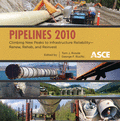Advancements in FRP Repair of PCCP
Publication: Pipelines 2010: Climbing New Peaks to Infrastructure Reliability: Renew, Rehab, and Reinvest
Abstract
Since its inception, application of carbon fiber liners for the retrofit of degrading Prestress Concrete Cylinder Pipe (PCCP), have evolved in both design and application. Carbon Fiber Liners have roots in bridge design. This is where the California Department of Transportation (Cal Trans) studied the use of Carbon Composite materials to retrofit bridge columns for improved performance during seismic events. The Department's study proved successful through the efforts of a couple of small innovative Southern California based companies. Upon completion of the composite bridge study these companies were positioned with advanced materials and application methods. Coincidentally, the development of advanced Fiber Reinforced Composite materials for the Civil industry occurred at the time when PCCP failures were happening at an alarming rate in North America. PCCP water-main failures were more than an inconvenience to the managing public agencies. Failures proved to be very costly in both repair and loss water sales. PCCP failures threatened public safety, property, as well as stimulating political unrest aimed at the managing public agencies. Pipeline professionals recognized the advantages offered by carbon composites for the retrofit of degrading PCCP over existing repair methods. Existing repair methods include: Remove and Replace, Slip Lining, and Relocation. The benefits offered by Carbon Liners over these conventional repair methods come from the fact that installation of FRP liners do not require exaction or extended planning and repair schedules common to conventional repair methods. This is very important property of FRP liners because it allows feeders to be repaired during the same pipeline shutdown where the distress was uncovered, allowing the pipeline to be brought back in to service in a very short window fully retrofitted. Prior to the development of the FRP liner technology agencies faced bringing a defective feeder back into service while planning its future repair with convention methods. Bringing a defective feeder back in to service without first repairing it is what I term the "cross your fingers approach to public safety". Needless to say, the cross your fingers method of repair is not recommended. During the infancy of FRP liners Pipe Owners did not know how to design or specify the product. Early liners were designed through a combination of lessons learned through the Cal-trans study, conventional analysis used by Civil Engineers, with the application of limited laboratory test data performed on PCCP lined with carbon composites. The emerging design models offered the foundation for Carbon Fiber Reinforced Polymer (CFRP) liners used today. Since the first installation in the mid 1990's the design and installation of CFRP liners has evolved through the cooperative efforts of both pipe owners and the private sector. A discussion of this evolution follows.
Get full access to this article
View all available purchase options and get full access to this chapter.
Information & Authors
Information
Published In
Copyright
© 2010 American Society of Civil Engineers.
History
Published online: Apr 26, 2012
Authors
Metrics & Citations
Metrics
Citations
Download citation
If you have the appropriate software installed, you can download article citation data to the citation manager of your choice. Simply select your manager software from the list below and click Download.
